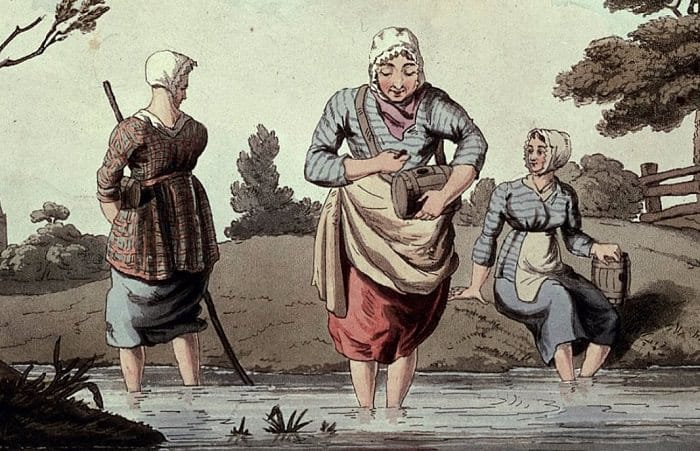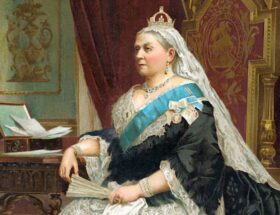Social History Book Review of Women of Victorian Sussex By Helena Wojtczak
Intro Comments to Page Edited by Pauline Weston Thomas for Fashion-Era.com
Introduction Comments
Those of you who seen my webpage on A Woman's Place, may be under the impression that if you had lived 150 years ago you might have been a lady of leisure dressing in a variety of outfits to represent your husband as his public acknowledgement of the niceties required of the new bourgeoisie society.
The reality is, that you like me, would more than likely have worked hard for a living. Perhaps worked in domestic service, maybe toiled in a dirty noisy mill or spent hours in a foul smelling brewery making beer or found respectable employment in the dressmaking or needle working trades, whilst fighting for recognition and approval in a male dominated society.
These were just a few of the 150 occupations that Helena Wojtczak lists in her latest publication
WOMEN OF VICTORIAN SUSSEX - Their Status, Occupations and Dealings with the Law, 1830 ~ 1870.
Because this site is about fashion, costume and social history, Helena was agreeable to my reprinting a short extract here. The extract below in the table is about the social and working conditions of women working in Victorian manufacturing and in particular trades that used the needle.
I found this particularly fascinating as my own great grandmother was a tailoress, and I only found this out in the last few years when the census information was released.
Her photograph shows her as a well groomed respectable family person. Whilst many working women may well have had a reasonable life, just as many will have had a tough existence in female jobs way beyond our imagination.
Here is the extract from Helena Wojtczak's Latest Publication WOMEN OF VICTORIAN SUSSEX - Their Status, Occupations and Dealings with the Law, 1830 ~ 1870.
Their Status, Occupations and Dealings with the Law, 1830 ~ 1870.
Helena Wojtczak's Latest Publication pictured left, deals with the status, occupations, and dealings of women with the law, in late Georgian to mid-Victorian England.
The well-groomed woman of some substance seated in this photograph is wearing a gown circa 1863-64. Note the banana-shaped sleeves and evenly domed crinoline skirt which did not become flat at the front until 1865, when fullness also moved to the skirt's back creating a more triangular silhouette. The mature hairstyle is also of the early 1860s. Image courtesy of Hastings Press website where you can buy this book.
This work is a unique piece of research in areas so far neglected - women's occupations and their dealings with the law as plaintiffs and defendants. The author writes in a plain and straightforward style, which makes the book suitable for any adult reader.
A comprehensive introductory chapter tells you all the background information you need to know about women's status in the mid-19th century so that the main sections of the book are put into context.
This book is highly educational, but at the same time entertaining. The many illustrations will amaze people who thought Victorian women did not go out to work or were not involved in business or trades. This book is a microcosm of Englishwomen's lives in the mid-19th century.
Helena Wojtczak's erudite, well-researched social history book shown above, is available for sale directly from Hastings Press. You can read much more in the book about the social conditions of the working lives of ordinary women and how they made a life for themselves, despite the hazards of their employment.
At the Hastings Press site, you can also read about other social history books which feature work in the last two centuries.
Extract Below Reprinted With Kind Permission of Hastings Press
WOMEN OF VICTORIAN SUSSEX - Their Status, Occupations, and Dealings with the Law, 1830 ~ 1870. By Helena Wojtczak
MANUFACTURING
Helena Wojtczak writes:- The clothing industry was the second largest employer of women (the largest being domestic service). It encompassed a wide range of different workers, including dressmakers, shirt-makers, makers of underclothing, milliners, hatters, glovers, hosiers, straw bonnet makers, collar-makers, tailors, patten-makers and shoe- and boot-makers.
Women also made accessories; among them were lapidaries*, embroiderers, lace-makers and lace-joiners, gaiter-makers, furriers, curriers† , and feather-workers. There were just under a million British women working in the clothing trades in 1871. The greatest number was concentrated in dressmaking and millinery, which occupied 267,000 women in 1851 and 300,00 in 1871.
In the mid-19th century, clothing manufacture was still entirely in the hands of small traders. Milliners and dressmakers occupied the higher end of female ‘needle-employment’ and at least one operated in every village, while towns abounded with them.
Needlework was seen as a natural profession for women because it was sedentary and was traditionally performed for the care and maintenance of the family. Within this industry, a woman might be an employee, an apprentice, a sole proprietress or an employer.
A sole proprietress would perform the work in her own home. If she prospered, assistants would be engaged and, at some point, depending on the size of her house, she might move out to a workshop or have one built onto the house.
She might also engage one or more apprentices. Girls had been apprentices for hundreds of years, but the practise was in decline. There were fewer apprenticeships for girls in all trades in the 19th century than there had been in the 18th, partly owing to the separation of work and home, and also because of the increased costs of establishing a business1.
Nevertheless, some girls managed to secure apprenticeships in small workshops. Millinery required an apprenticeship of up to seven years, during which time a girl received no wages; in fact, fees were charged. It was, therefore, a father’s decision whether to pay for his daughter to be apprenticed.
An apprenticeship offered a sense of belonging to a trade, and gave women the opportunity to earn a reasonable living and the skills to work for themselves in the future.
~~~~~~~
In the clothing trades, employment for journeywomen (day workers) was not lucrative.
The problem was that every girl was taught to sew, and needlework thus became the first resort of any woman who had no special skills but needed to earn money. It was also the kind of work that a middle-class woman down on her luck might easily take up.
Because of the availability of labor, the hours were excessively long and the pay pitifully low. In 1862 a lady journalist warned, ‘All who are wise will avoid this profession because such numbers crowd into it, that the competition drives the payment down to a point below that at which life can be sustained.’ 2
Thanks to the large number of well-to-do lady visitors and residents of Sussex there was plenty of skilled dressmaking work available, particularly in the summer months.
Upper-class ladies dressed to impress and kept their dressmakers very busy creating, ornamenting, mending, and altering garments. Upper-crust lady milliners took business trips to Paris and, on their return, placed newspaper advertisements to advise customers that they were fully apprised of the very latest French fashions, then considered the height of elegance.
As it was unthinkable to venture outdoors without a hat or bonnet, manufacturers of headgear also did a roaring trade, selling ready-made items as well as designing and making them to order. Even the relatively small town of Hastings had 249 adult female milliners in 1851.
As well as hats and bonnets, milliners made caps, cloaks, mantles, gloves, scarves, muffs, tippets#, handkerchiefs, petticoats, hoods and capes.
With so much work available, especially in Brighton with its numerous wealthy lady visitors, it is intriguing that milliner Lucy Coats of that town was declared bankrupt in 1868 with debts of £110 18s 6d and assets, nil. It seems likely that she was beset by illness or other bad luck, for other milliners were doing extremely well.
During 1834 there was a tailors’ strike and local needlewomen quickly turned their hands to this traditional male skill. When the men returned to work, some of the women failed to revert to their former, ill-paid specialties; indeed, some married tailors and worked alongside them.
Making stays and upholstery were two more male preserves that women were entering by the 1850s. Staymaking required considerable physical strength and women in this line of business may have employed male labor to assist with the heavier work.
~~~~~~~
Nationally, the skilled millinery and dressmaking trades were damaged by the growing demand for cheap, ready-made clothing. From the 1840s some garments began to be cut in quantities on a band-saw and then given to needlewomen to finish off at home at very low piece rates.
These ‘slop-workers’ became a cause célèbre after an 1843 report in the satirical magazine Punch shocked the public with stories of their cruel exploitation, and of how they lived, worked and died in miserable conditions, often resorting to the pawn shop, prostitution, and even theft to keep themselves from starving. Indeed, cases were brought before Sussex magistrates in which a milliner or dressmaker had pawned the material given by a client.
In the 1870s, the sewing machine began to come into use in Sussex as elsewhere; a small handful of machinists appears in the 1871 Census, working for dressmakers and tailors.
~~~~~~~
1. Alexander, Sally, ‘Women’s Work in Nineteenth-Century London’ in Mitchell, J., and Oakley, A., (1976) The Rights and Wrongs of Women and Ivy Pinchbeck (1930). Women workers and the Industrial Revolution.
2. Boucherett, J., (1862) On the Choice of a Business.
* Jewellery-makers.
† Leather dressers.
# A fur shoulder cape with hanging ends, often consisting of the fur of a fox.
End of Helena Wojtczak's writing. Extract Above Reprinted with Kind Permission of Hastings Press
Some points that may be of special interest to fashion-era visitors would be the reference to men being staymakers and another reference to patten makers. Please note patten is the correct spelling and the word is not intended to be pattern.
Pattens were worn on the outside of normal shoes as a form of overshoe. They lifted the foot away from the street mud and muck, keeping feet clean and dry. The sole of pattens was often made of wood, like a clog or modern wooden Scholl sandal. It also had a small piece of leather that passed as an upper and held the patten onto the shoe.
In the early days of making stays and crinolines real whalebone was used. Cutting the whalebone would have been heavy and unpleasant work which is why men were often employed to help women with staymaking.
If you are interested in more detailed information from Helena's book, I suggest you peruse the Hastings Press webpages to obtain a copy. You may also find additional material I wrote about women seamstresses in my Edwardian era section useful. You can also read how people bought slop clothes here at my page on Shopping in the Past in Victorian and Edwardian times.
My thanks to Hastings Press and Helena Wojtczak for allowing this section of her book to be reprinted here at www.fashion-era.com
Page added 13 May 2005


